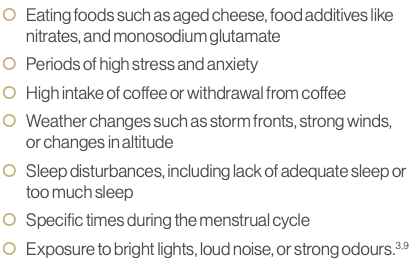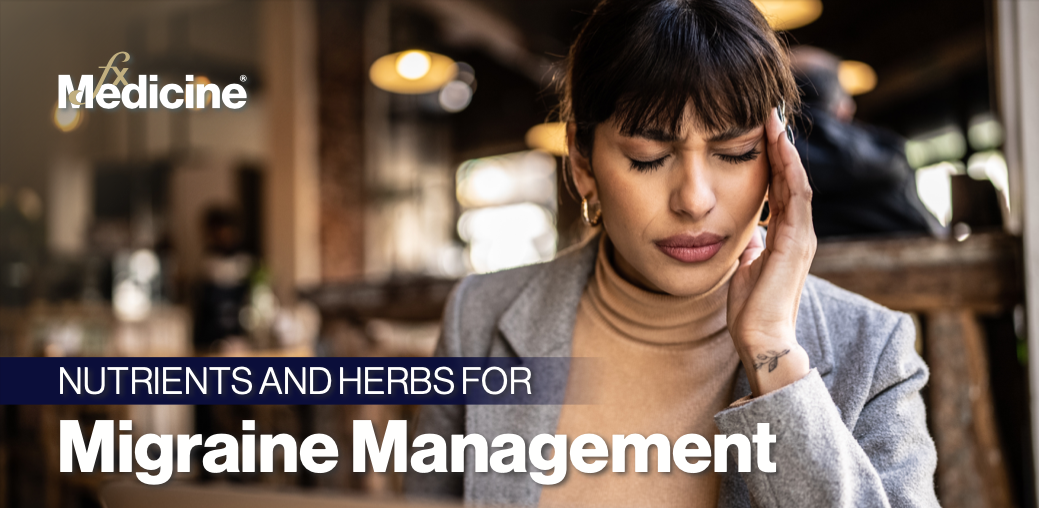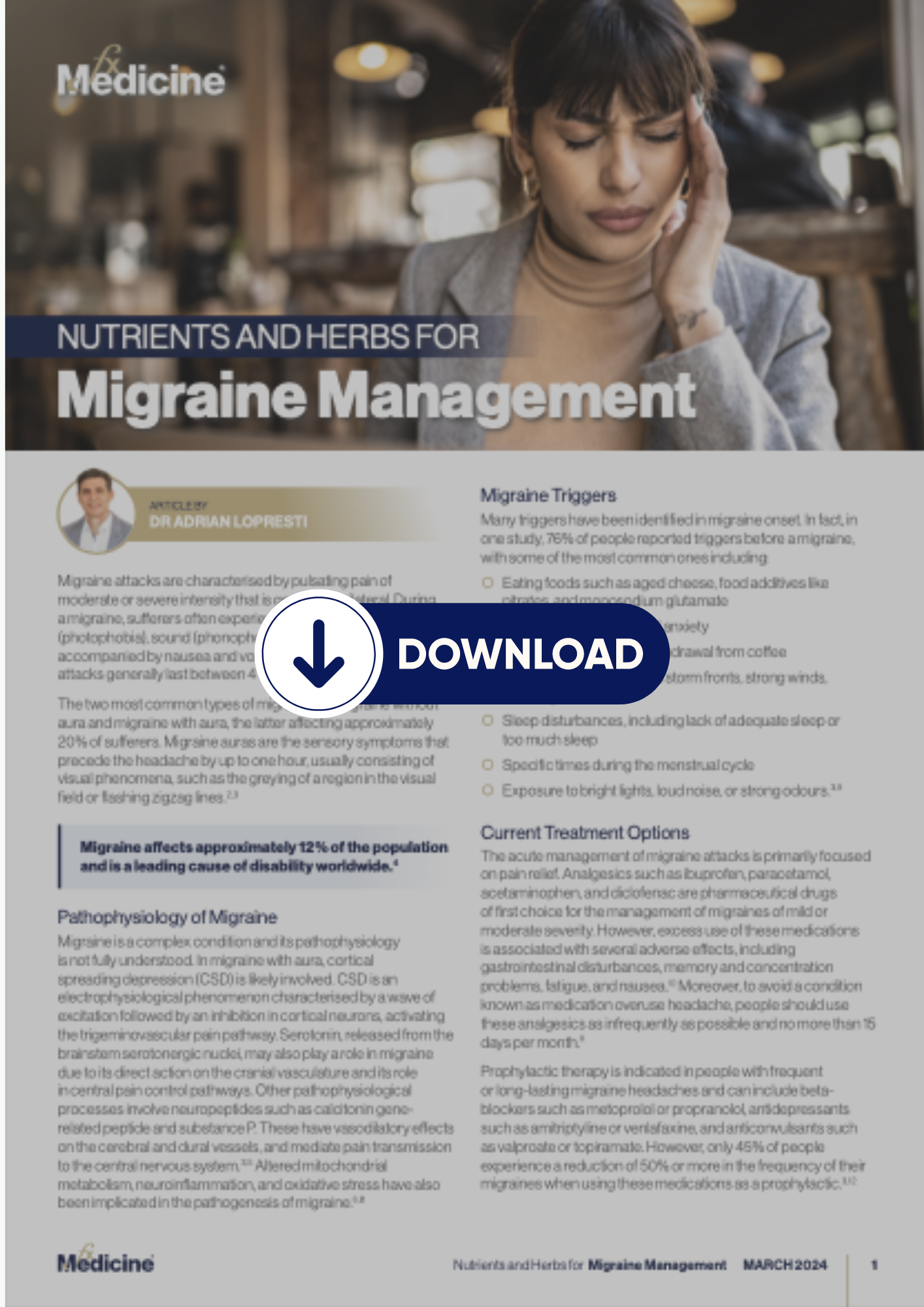Migraine attacks are characterised by pulsating pain of moderate or severe intensity that is generally unilateral. During a migraine, sufferers often experience hypersensitivity to light (photophobia), sound (phonophobia), and smell (osmophobia), accompanied by nausea and vomiting. If unsuccessfully treated, attacks generally last between 4 to 72 hours.1
The two most common types of migraine are migraine without aura and migraine with aura, the latter affecting approximately 20% of sufferers. Migraine auras are the sensory symptoms that precede the headache by up to one hour, usually consisting of visual phenomena, such as the greying of a region in the visual field or flashing zigzag lines.2,3

Pathophysiology of Migraine
Migraine is a complex condition and its pathophysiology is not fully understood. In migraine with aura, cortical spreading depression (CSD) is likely involved. CSD is an electrophysiological phenomenon characterised by a wave of excitation followed by an inhibition in cortical neurons, activating the trigeminovascular pain pathway. Serotonin, released from the brainstem serotonergic nuclei, may also play a role in migraine due to its direct action on the cranial vasculature and its role in central pain control pathways. Other pathophysiological processes involve neuropeptides such as calcitonin gene- related peptide and substance P. These have vasodilatory effects on the cerebral and dural vessels, and mediate pain transmission to the central nervous system.3,5 Altered mitochondrial metabolism, neuroinflammation, and oxidative stress have also been implicated in the pathogenesis of migraine.6,8
Migraine Triggers
Many triggers have been identified in migraine onset. In fact, in one study, 76% of people reported triggers before a migraine, with some of the most common ones including:

Current Treatment Options
The acute management of migraine attacks is primarily focused on pain relief. Analgesics such as ibuprofen, paracetamol, acetaminophen, and diclofenac are pharmaceutical drugs of first choice for the management of migraines of mild or moderate severity. However, excess use of these medications is associated with several adverse effects, including gastrointestinal disturbances, memory and concentration problems, fatigue, and nausea.10 Moreover, to avoid a condition known as medication overuse headache, people should use these analgesics as infrequently as possible and no more than 15 days per month.11
Prophylactic therapy is indicated in people with frequent or long-lasting migraine headaches and can include beta- blockers such as metoprolol or propranolol, antidepressants such as amitriptyline or venlafaxine, and anticonvulsants such as valproate or topiramate. However, only 45% of people experience a reduction of 50% or more in the frequency of their migraines when using these medications as a prophylactic.3,12

Magnesium
Suboptimal magnesium status has repeatedly been identified in migraine sufferers, and magnesium is intimately tied to several physiological processes involved in migraine.13 For example, magnesium deficiency has been proposed as a trigger for CSD. Magnesium also influences the release of substance P, affects mitochondrial activity and inhibits calcium influx in neurons
by blocking N-methyl-d-aspartate receptors.14, 15 A review of studies on oral supplementation with magnesium concluded that magnesium reduced migraine frequency and severity. Overall, there was a 33% decrease in the frequency of migraine attacks.14 However, the role of oral magnesium supplementation in migraine prevention remains to be fully elucidated, although many different guidelines on the management of migraine across countries such as America, Canada, Germany, Italy, Switzerland and Hungary have indicated that magnesium is probably effective as a migraine prevention.1
Riboflavin
Riboflavin (vitamin B2) is an essential water-soluble vitamin
with antioxidant, anti-aging, anti-inflammatory, and anti- nociceptive effects. It has been proposed that 10–15% of
the world’s population is genetically restricted in riboflavin absorption and utilisation, and there is a potential for biochemical riboflavin deficiency worldwide.16 Riboflavin may help improve migraines through various mechanisms, including its ability to reduce oxidative stress and neuroinflammation and support mitochondrial activity.17, 18 The results of seven studies (including three randomised controlled trials), concluded that riboflavin prevented adult migraines.18
Coenzyme Q10
Coenzyme Q10 (CoQ10) is involved in many cellular redox reactions necessary for bioenergetics and antioxidant defence. A recent meta-analysis concluded that based on data from
six randomised controlled trials, CoQ10 did not significantly decrease the severity of migraines, however the duration and frequency of migraines were reduced.19
Herbal therapies
Because plants, herbs, and their active constituents can influence many processes associated with migraine pathophysiology, they present as an alternative or adjunct intervention to enhance current treatment outcomes. I published a systematic review of nineteen randomised controlled trials of herbal interventions for migraine, and concluded that the efficacy of feverfew was mixed, and there was positive, albeit limited evidence for butterbur. Moreover, there were positive preliminary findings on curcumin, citron, and coriander as a prophylactic treatment for migraines, and menthol and chamomile as an acute treatment. However, because the risk of bias was high for many studies, more studies are required.10
Conclusion
Migraine is a debilitating condition with a complex pathophysiology. Unfortunately, standard pharmaceutical treatments have only modest efficacy. Therefore, identifying alternative or adjunctive treatment options that are safe and effective is essential for sufferers. Along with dietary, lifestyle, and environmental changes, several nutritional and herbal ingredients used in isolation or synergistically may help relieve the frequency and severity of migraines.
Download a pdf copy of this article
References
1 Savi, L., Magnesium and migraine, in Treatments, Nutraceuticals, Supplements, and Herbal Medicine in Neurological Disorders, C.R. Martin, V.B. Patel, and V.R. Preedy, Editors. 2023, Elsevier Inc. p. 421-439.
2 Kaufman, D.M., et al., Headaches, in Kaufman's Clinical Neurology for Psychiatrists, D.M. Kaufman, et al., Editors. 2023, Elsevier Inc. p. 184-284.
3 Shankar Kikkeri, N. and S. Nagalli, Migraine With Aura, in StatPearls. 2024: Treasure Island (FL).
4 GBD 2015 Disease and Injury Incidence and Prevalence Collaborators, Global, regional, and national incidence, prevalence, and years lived with disability for 310 diseases and injuries, 1990-2015: a systematic analysis for the Global Burden of Disease Study 2015. Lancet, 2016. 388(10053): p. 1545-1602.
5 Charles, A., The pathophysiology of migraine: implications for clinical management. Lancet Neurol, 2018. 17(2): p. 174-182.
6 Wang, Y., et al., Energy metabolism disturbance in migraine: From a mitochondrial point of view. Front Physiol, 2023. 14: p.1133528.
7 Kursun, O., et al., Migraine and neuroinflammation: the inflammasome perspective. J Headache Pain, 2021. 22(1): p. 55.
8 Borkum, J.M., Migraine Triggers and Oxidative Stress: A Narrative Review and Synthesis. Headache, 2016. 56(1): p. 12-35.
9 Kelman, L., The triggers or precipitants of the acute migraine attack. Cephalalgia, 2007. 27(5): p. 394-402.
10 Lopresti, A.L., S.J. Smith, and P.D. Drummond, Herbal treatments for migraine: A systematic review of randomised-controlled studies. Phytother Res, 2020. 34(10): p. 2493-2517.
11 Gooriah, R., R. Nimeri, and F. Ahmed, Evidence-Based Treatments for Adults with Migraine. Pain Res Treat, 2015. 2015: p.629382.
12 D'Amico, D. and S.J. Tepper, Prophylaxis of migraine: general principles and patient acceptance. Neuropsychiatr Dis Treat, 2008.4(6): p. 1155-67.
13 Teigen, L. and C.J. Boes, An evidence-based review of oral magnesium supplementation in the preventive treatment of migraine. Cephalalgia, 2015. 35(10): p. 912-22.
14 Chiu, H.Y., et al., Effects of Intravenous and Oral Magnesium on Reducing Migraine: A Meta-analysis of Randomized Controlled Trials. Pain Physician, 2016. 19(1): p. E97-112.
15 Domitrz, I. and J. Cegielska, Magnesium as an Important Factor in the Pathogenesis and Treatment of Migraine-From Theory to Practice. Nutrients, 2022. 14(5).
16 Sinigaglia-Coimbra, R., A.C. Lopes, and C.G. Coimbra, Riboflavin deficiency, brain function, and health, in Handbook of Behavior, Food and Nutrition, V.R. Preedy, R.R. Watson, and C.R. Martin, Editors. 2011, Springer. p. 2427–2449.
17 Marashly, E.T. and S.A. Bohlega, Riboflavin Has Neuroprotective Potential: Focus on Parkinson's Disease and Migraine. Front Neurol, 2017. 8: p. 333.
18 Yamanaka, G., et al., Experimental and Clinical Evidence of the Effectiveness of Riboflavin on Migraines. Nutrients, 2021. 13(8). 19 Sazali, S., et al., Coenzyme Q10 supplementation for prophylaxis in adult patients with migraine-a meta-analysis. BMJ Open, 2021. 11(1): p. e039358.



